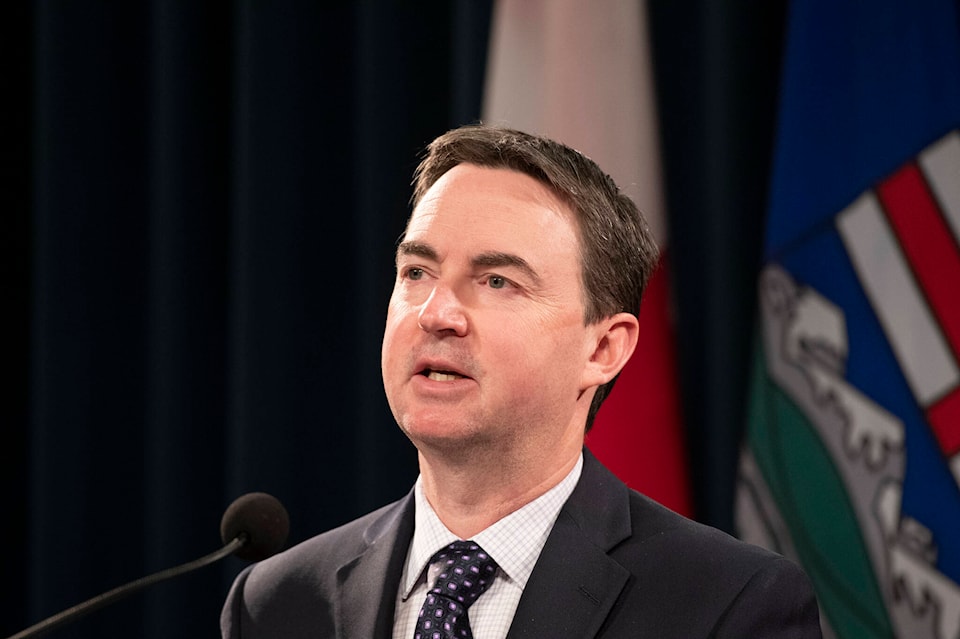The Alberta government is reducing capacity limits at large venues as the Omicron COVID-19 variant becomes more prevalent in the province.
In an announcement Tuesday, Minister of Health Jason Copping, said any venue with more than 1,000 people will be subject to a 50 per cent capacity limit and venues with a capacity between 500 and 1,000 are capped at 500. The changes will take place at midnight on Dec. 24.
“Unfortunately, Omicron has made it necessary for us to make a few more changes to reduce contacts and slow the spread of the virus,” Copping said.
“Due to the risk of breakthrough infections, we need to make adjustments.”
Copping said people attending those venues should remain masked at all times and consuming food and drinks is not permitted in “seated audience situations” in large venues.
“With the increased transmission risk of Omicron, it is important that the overall number of people mixing in venues be limited and that attendees remain masked at all times,” Copping said.
“As the premier said, we need to avoid super spreader events,” he said referring to Premier Jason Kenney.
Copping said the changes will apply to NHL games and the 2022 World Junior Hockey Championships.
Restaurants and bars will be limited to 10 people per table and no activities like dancing or billiards will be permitted. Businesses participating in the Restrictions Exemption program will also need to stop alcohol service at 11 p.m. and close by 12:30 a.m.
The province is also asking Albertans to limit their daily in-person contacts by half over the coming weeks. Officials are asking those who test positive with a rapid test kit to isolate and book a PCR test as soon as possible.
“We ask Albertans to take a close look at their plans and consider how they can reduce their interactions,” Copping said, adding he encourages any workplaces to cancel holiday parties.
With the announcement of new public health measures, the province identified 786 new cases of the virus, based on about 7,300 tests for a positivity rate of about 11 per cent.
The province has 6,045 active cases of the virus, with 329 people in hospital infected with the virus and 69 people in ICU. There were two new deaths due to the implications of COVID-19, bringing the total to 3,294.
Kenney explained that the province is still learning all it can about the Omicron variant. He noted that in the last month the new variant has gone from less than 10 per cent of new COVID-19 cases to over 50 per cent in the last week.
Alberta’s chief medical officer of health Dr. Deena Hinshaw explained that data from Alberta and around the world point to Omicron doubling nearly every 2-3 days. She noted Alberta now has 1,609 active cases of the Omicron variant alone. Twenty-nine cases of the Omicron variant have been identified in the Central zone.
“Omicron is now our dominant strain and there is increasing community transmission in the province,” she said adding the province has redirected its contact tracing to high-risk settings.
“If someone tests positive for COVID-19, they should assume that they have the Omicron variant.”
Hinshaw added she has cancelled her holiday plans and expects over the next few weeks to see transmission “rise to heights we have never seen before.”
“We are facing a significant and unknown threat. The next few weeks will be critical in determining what the new year will look like,” she said.
The Central zone sits at 464 active cases of the virus, with 61 people in hospital, including 32 in the ICU. There have been 412 deaths in the zone due to the implications of COVID-19.
Red Deer sits 94 at active cases of COVID-19, according to geospatial mapping on the provincial government’s website. There are 9,557 cases in the city overall, with 9,373 recovered and 84 deaths due to the implications of COVID-19.
Stettler County has 96 active cases, Clearwater County has 29, Mountain View County has 28, Red Deer County and Lacombe County each have 21, the City of Lacombe has 19, Olds has 13 and Sylvan Lake has six.
Wetaskiwin, including Maskwacis, has 23 active cases, while Ponoka, including East Ponoka County, has five and Rimbey, including West Ponoka County and part of Lacombe County, has one.
The City of Camrose has 34, Kneehill County has seven, Camrose County has five and Drumheller has three.
byron.hackett@reddeeradvocate.com
Like us on Facebook and follow us on Twitter
